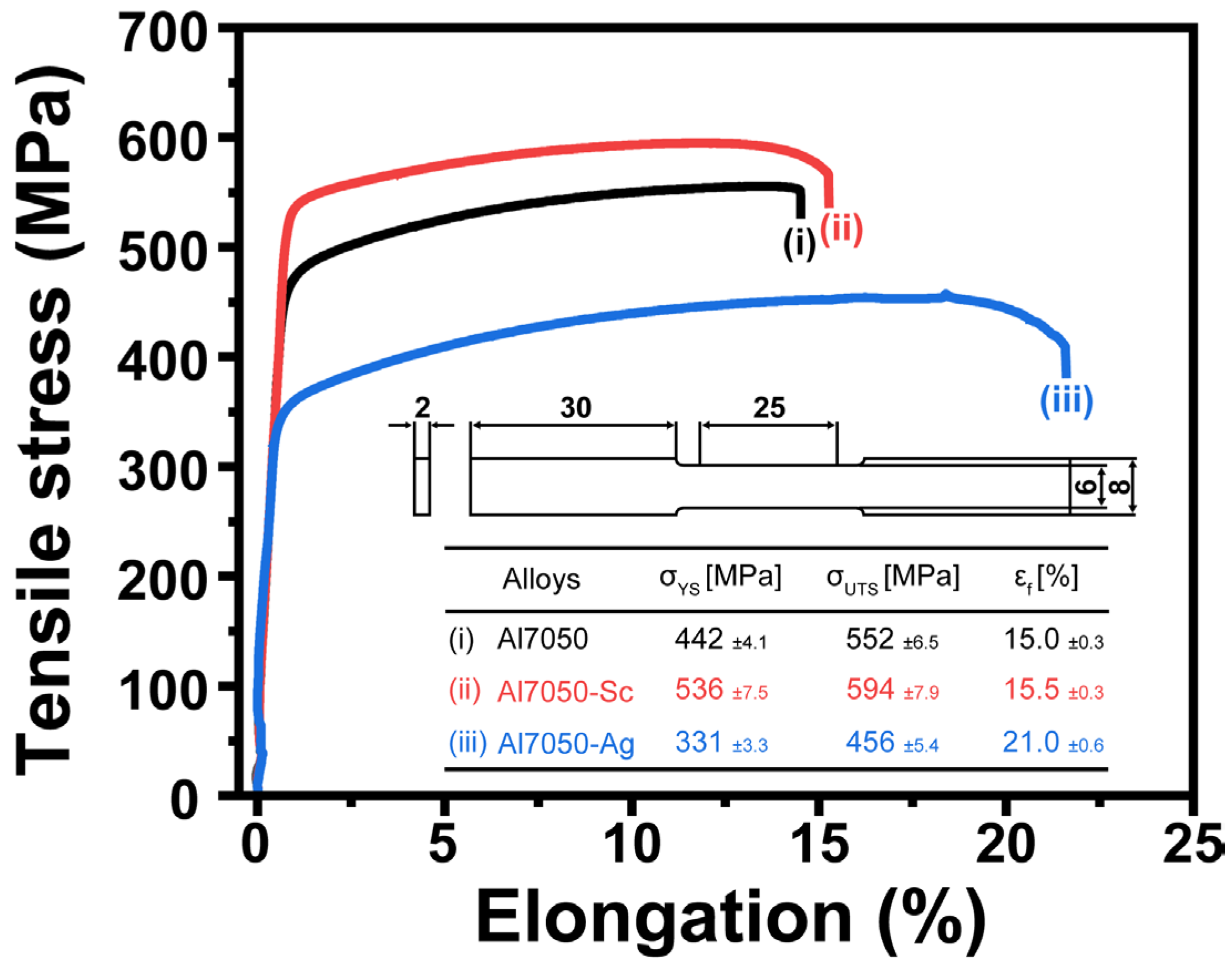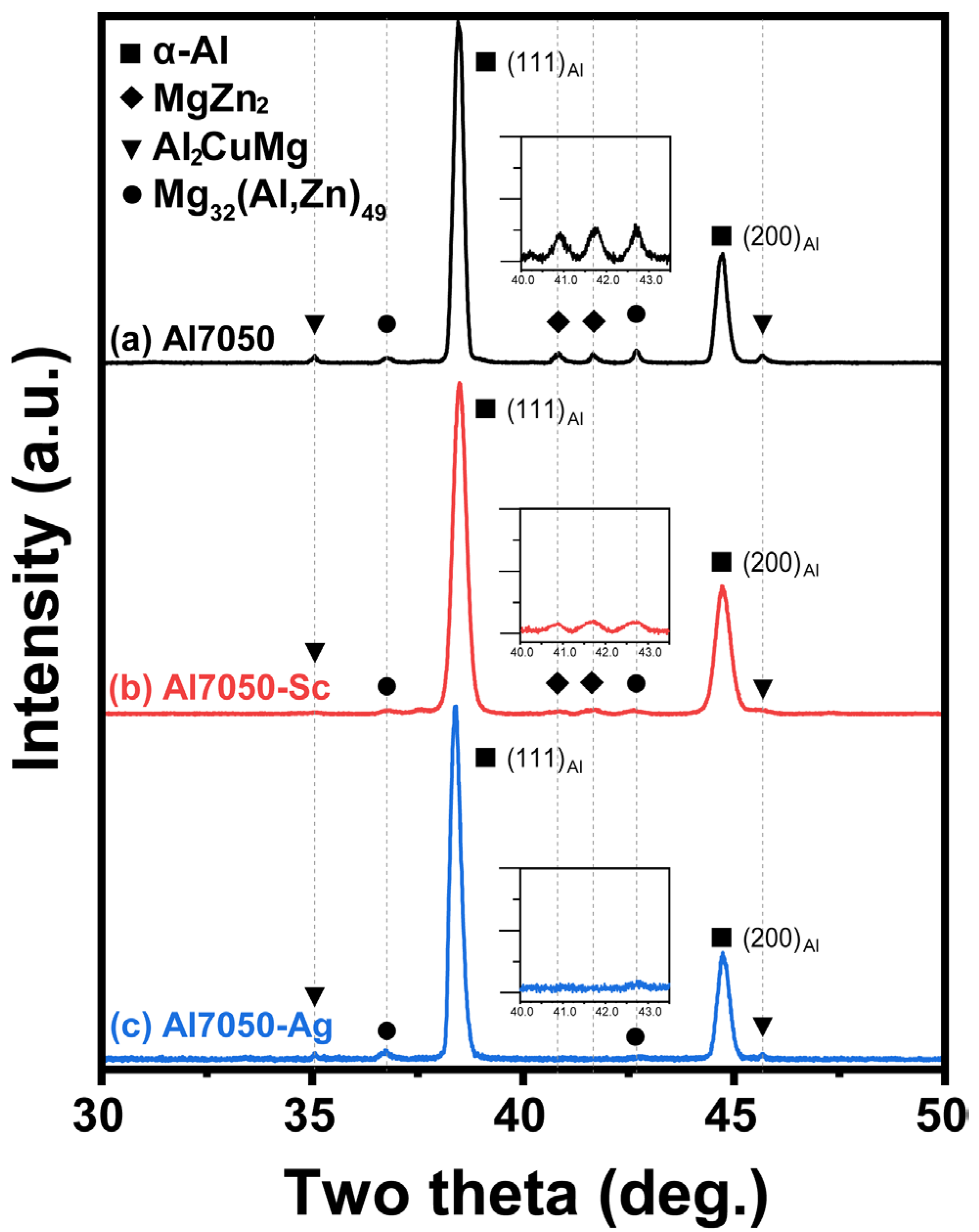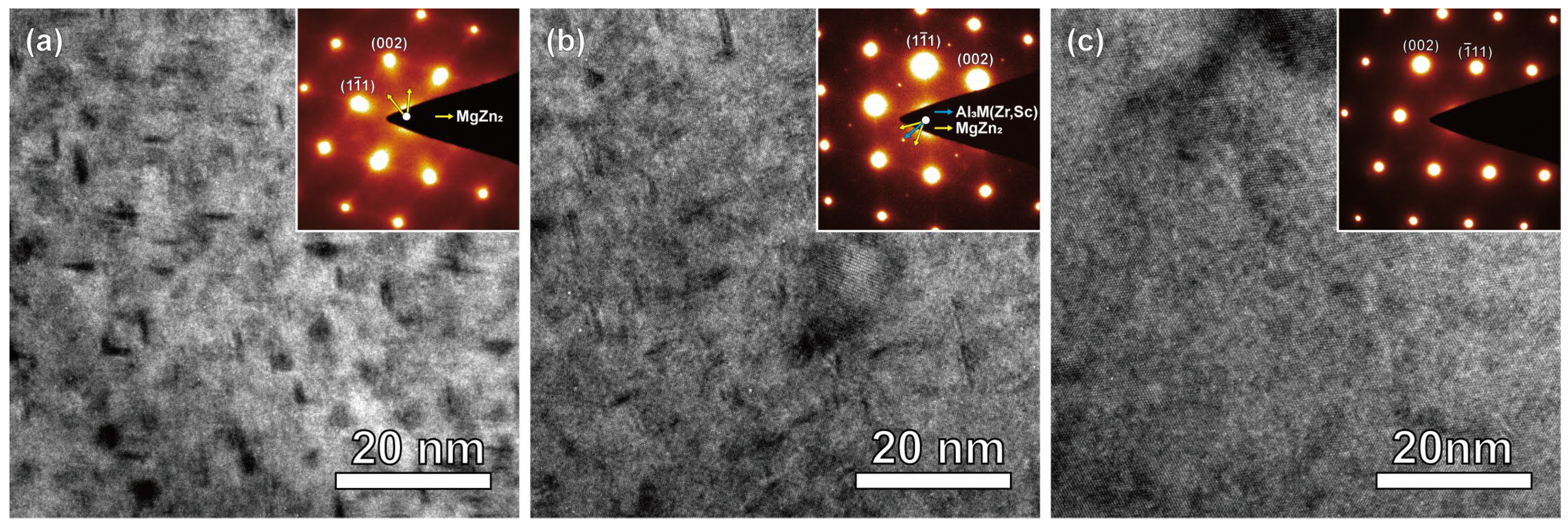Roles of Sc and Ag Microalloying Elements in the Mechanical Properties of Al-Zn-Mg-Cu (Al7xxx) Alloy
Abstract
1. Introduction
2. Experimental Procedures
3. Results
4. Discussion
5. Conclusions
- (1)
- Sc and Ag microalloying elements impede the formation of intermetallic particles (S, T, η phases) in Al7050 alloys.
- (2)
- Sc microalloying element facilitates the precipitate formation process of the GP-zone → metastable η’ phase, while the process of metastable η’ phase → stable η phase is severely restricted. The formation of hardening η’ phase greatly improves the tensile strength of the Al7050 alloy.
- (3)
- The major hardening precipitates of η’ (MgZn2) phase are restricted to form in the Al7050 alloy via Ag microalloying.
Author Contributions
Funding
Institutional Review Board Statement
Informed Consent Statement
Data Availability Statement
Acknowledgments
Conflicts of Interest
References
- Embury, J.; Nicholson, R. The nucleation of precipitates: The system Al-Zn-Mg. Acta Metall. 1965, 13, 403–417. [Google Scholar] [CrossRef]
- Chen, Y.; Gao, N.; Sha, G.; Ringer, S.P.; Starink, M.J. Microstructural evolution, strengthening and thermal stability of an ultrafine-grained Al–Cu–Mg alloy. Acta Mater. 2016, 109, 202–212. [Google Scholar] [CrossRef]
- Marlaud, T.; Deschamps, A.; Bley, F.; Lefebvre, W.; Baroux, B. Influence of alloy composition and heat treatment on precipitate composition in Al–Zn–Mg–Cu alloys. Acta Mater. 2010, 58, 248–260. [Google Scholar] [CrossRef]
- Starink, M.; Wang, S. A model for the yield strength of overaged Al–Zn–Mg–Cu alloys. Acta Mater. 2003, 51, 5131–5150. [Google Scholar] [CrossRef]
- Zuo, J.; Hou, L.; Shu, X.; Peng, W.; Yin, A.; Zhang, J. Grain refinement assisted by deformation enhanced precipitates through thermomechanical treatment of AA7055 Al alloy. Metals 2020, 10, 594. [Google Scholar] [CrossRef]
- Zuo, J.; Hou, L.; Shi, J.; Cui, H.; Zhuang, L.; Zhang, J. The mechanism of grain refinement and plasticity enhancement by an improved thermomechanical treatment of 7055 Al alloy. Mater. Sci. Eng. A 2017, 702, 42–52. [Google Scholar] [CrossRef]
- Liu, J.; Yao, P.; Zhao, N.; Shi, C.; Li, H.; Li, X.; Xi, D.; Yang, S. Effect of minor Sc and Zr on recrystallization behavior and mechanical properties of novel Al–Zn–Mg–Cu alloys. J. Alloys Compd. 2016, 657, 717–725. [Google Scholar] [CrossRef]
- Wu, Y.-L.; Li, C.; Alvarez, A. Microalloying of Sc, Ni, and Ce in an advanced Al-Zn-Mg-Cu alloy. Metall. Mater. Trans. A 1999, 30, 1017–1024. [Google Scholar] [CrossRef]
- Reich, L.; Murayama, M.; Hono, K. Evolution of Ω phase in an Al–Cu–Mg–Ag alloy—A three-dimensional atom probe study. Acta Mater. 1998, 46, 6053–6062. [Google Scholar] [CrossRef]
- Gazizov, M.; Teleshov, V.; Zakharov, V.; Kaibyshev, R. Solidification behaviour and the effects of homogenisation on the structure of an Al–Cu–Mg–Ag–Sc alloy. J. Alloys Compd. 2011, 509, 9497–9507. [Google Scholar] [CrossRef]
- Zhu, Q.; Cao, L.; Wu, X.; Zou, Y.; Couper, M.J. Effect of Ag on age-hardening response of Al-Zn-Mg-Cu alloys. Mater. Sci. Eng. A 2019, 754, 265–268. [Google Scholar] [CrossRef]
- Ying, T.; Gu, L.; Tang, X.; Wang, J.; Zeng, X. Effect of Sc microalloying on microstructure evolution and mechanical properties of extruded Al–Zn–Mg–Cu alloys. Mater. Sci. Eng. A 2022, 831, 142197. [Google Scholar] [CrossRef]
- Freiberg, D.; Zhu, W.; Park, J.-S.; Almer, J.D.; Sanders, P. Precipitate characterization in model Al-Zn-Mg-(Cu) alloys using small-angle X-ray scattering. Metals 2020, 10, 959. [Google Scholar] [CrossRef]
- Ogura, T.; Hirosawa, S.; Cerezo, A.; Sato, T. Atom probe tomography of nanoscale microstructures within precipitate free zones in Al–Zn–Mg (–Ag) alloys. Acta Mater. 2010, 58, 5714–5723. [Google Scholar] [CrossRef]
- Zhang, M.; Liu, T.; He, C.; Ding, J.; Liu, E.; Shi, C.; Li, J.; Zhao, N. Evolution of microstructure and properties of Al–Zn–Mg–Cu–Sc–Zr alloy during aging treatment. J. Alloys Compd. 2016, 658, 946–951. [Google Scholar] [CrossRef]
- Won, S.-J.; So, H.; Kang, L.; Oh, S.J.; Kim, K.-H. Development of a high-strength Al-Zn-Mg-Cu-based alloy via multi-strengthening mechanisms. Scr. Mater. 2021, 205, 114216. [Google Scholar] [CrossRef]
- Yoganjaneyulu, G.; Babu, K.A.; Siva, G.V.; Vigneshwaran, S.; Narayanan, C.S. Microstructure and mechanical properties of Al–6 Zn–3 Mg–2 Cu–0.5 Sc alloy. Mater. Lett. 2019, 253, 18–21. [Google Scholar] [CrossRef]
- So, H.; Won, S.-J.; Park, J.; Oh, S.J.; Kang, L.; Kim, K.-H. Mechanical properties and microstructural evolution in Al–Cu–Mg–Ag alloy with a CuxMgx/10 content. Mater. Sci. Eng. A 2021, 824, 141573. [Google Scholar] [CrossRef]
- Li, B.; Liang, S.; Wen, S.; Zhao, Z.; Wu, X.; Wang, W.; Gao, K.; Huang, H.; Nie, Z. Competition between precipitation and segregation of Sc and its effects on thermal stability of Al-Cu-Mg-Ag alloys. Mater. Lett. 2021, 297, 129927. [Google Scholar] [CrossRef]
- Staley, J.; Brown, R.; Schmidt, R. Heat treating characteristics of high strength Al-Zn-Mg-Cu alloys with and without silver additions. Metall. Mater. Trans. B 1972, 3, 191–199. [Google Scholar] [CrossRef]
- Lin, L.; Liu, Z.; Liu, W.; Zhou, Y.; Huang, T. Effects of Ag addition on precipitation and fatigue crack propagation behavior of a medium-strength Al–Zn–Mg alloy. J. Mater. Sci. Tec. 2018, 34, 534–540. [Google Scholar] [CrossRef]
- Chung, T.-F.; Yang, Y.-L.; Shiojiri, M.; Hsiao, C.-N.; Li, W.-C.; Tsao, C.-S.; Shi, Z.; Lin, J.; Yang, J.-R. An atomic scale structural investigation of nanometre-sized η precipitates in the 7050 aluminium alloy. Acta Mater. 2019, 174, 351–368. [Google Scholar] [CrossRef]
- Sha, G.; Cerezo, A. Early-stage precipitation in Al–Zn–Mg–Cu alloy (7050). Acta Mater. 2004, 52, 4503–4516. [Google Scholar] [CrossRef]
- Carvalho, A.; Renaudin, L.; Zara, A.; Martins, J. Microstructure analysis of 7050 aluminum alloy processed by multistage aging treatments. J. Alloys Compd. 2022, 907, 164400. [Google Scholar] [CrossRef]
- Zhou, B.; Liu, B.; Zhang, S. The advancement of 7xxx series aluminum alloys for aircraft structures: A review. Metals 2021, 11, 718. [Google Scholar] [CrossRef]
- Deng, Y.; Zhang, Y.; Wan, L.; Zhang, X. Effects of thermomechanical processing on production of Al–Zn–Mg–Cu alloy plate. Mater. Sci. Eng. A 2012, 554, 33–40. [Google Scholar] [CrossRef]
- Kheradmand, A.B.; Tayebi, M.; Akbari, M.M.; Abbasian, A. Effect of quench-controlled precipitation hardening on microstructure and mechanical properties of Al-Zn-Mg-Cu-Zr alloys contain of Sc micro-alloying. J. Alloys Compd. 2022, 902, 163748. [Google Scholar] [CrossRef]
- Zhao, Y.; Li, Y.; Yeli, G.; Luan, J.; Liu, S.; Lin, W.; Chen, D.; Liu, X.; Kai, J.; Liu, C. Anomalous precipitate-size-dependent ductility in multicomponent high-entropy alloys with dense nanoscale precipitates. Acta Mater. 2022, 223, 117480. [Google Scholar] [CrossRef]
- Zou, Y.; Wu, X.; Tang, S.; Zhu, Q.; Song, H.; Cao, L. Co-precipitation of T′ and η′ phase in Al-Zn-Mg-Cu alloys. Mater. Charact. 2020, 169, 110610. [Google Scholar] [CrossRef]
- Li, X.; Hansen, V.; Gjønnes, J.; Wallenberg, L. HREM study and structure modeling of the η′ phase, the hardening precipitates in commercial Al–Zn–Mg alloys. Acta Mater. 1999, 47, 2651–2659. [Google Scholar] [CrossRef]
- Fang, X.; Song, M.; Li, K.; Du, Y.; Zhao, D.; Jiang, C.; Zhang, H. Effects of Cu and Al on the crystal structure and composition of η (MgZn2) phase in over-aged Al–Zn–Mg–Cu alloys. J. Mater. Sci. 2012, 47, 5419–5427. [Google Scholar] [CrossRef]
- Novotny, G.M.; Ardell, A.J. Precipitation of Al3Sc in binary Al–Sc alloys. Mater. Sci. Eng. A 2001, 318, 144–154. [Google Scholar] [CrossRef]
- Zhang, Y.; Weyland, M.; Milkereit, B.; Reich, M.; Rometsch, P.A. Precipitation of a new platelet phase during the quenching of an Al-Zn-Mg-Cu alloy. Sci. Rep. 2016, 6, 23109. [Google Scholar] [CrossRef] [PubMed]
- Dos Santos, J.F.; Staron, P.; Fischer, T.; Robson, J.D.; Kostka, A.; Colegrove, P.; Wang, H.; Hilgert, J.; Bergmann, L.; Hütsch, L.L. Understanding precipitate evolution during friction stir welding of Al-Zn-Mg-Cu alloy through in-situ measurement coupled with simulation. Acta Mater. 2018, 148, 163–172. [Google Scholar] [CrossRef]
- Mazzer, E.; Afonso, C.; Galano, M.; Kiminami, C.; Bolfarini, C. Microstructure evolution and mechanical properties of Al–Zn–Mg–Cu alloy reprocessed by spray-forming and heat treated at peak aged condition. J. Alloys Compd. 2013, 579, 169–173. [Google Scholar] [CrossRef]
- Ghiaasiaan, R.; Amirkhiz, B.S.; Shankar, S. Quantitative metallography of precipitating and secondary phases after strengthening treatment of net shaped casting of Al-Zn-Mg-Cu (7000) alloys. Mater. Sci. Eng. A 2017, 698, 206–217. [Google Scholar] [CrossRef]
- Sun, Y.; Luo, Y.; Pan, Q.; Liu, B.; Long, L.; Wang, W.; Ye, J.; Huang, Z.; Xiang, S. Effect of Sc content on microstructure and properties of Al-Zn-Mg-Cu-Zr alloy. Mater. Today Commun. 2021, 26, 101899. [Google Scholar] [CrossRef]
- Kang, S.J.; Kim, Y.-W.; Kim, M.; Zuo, J.-M. Determination of interfacial atomic structure, misfits and energetics of Ω phase in Al–Cu–Mg–Ag alloy. Acta Mater. 2014, 81, 501–511. [Google Scholar] [CrossRef]




| Alloys | Chemical Composition (wt.%) | |||||||
|---|---|---|---|---|---|---|---|---|
| Al | Zn | Mg | Cu | Cr | Zr | Sc | Ag | |
| Al7050 | Bal. | 6.4 | 2.2 | 2.2 | 0.14 | 0.08 | - | - |
| Al7050-Sc | Bal. | 6.4 | 2.2 | 2.2 | 0.14 | 0.08 | 0.1 | - |
| Al7050-Ag | Bal. | 6.4 | 2.2 | 2.2 | 0.14 | 0.08 | - | 0.1 |
| Atomic % | ||||
|---|---|---|---|---|
| Al | Zn | Mg | Cu | |
| (a) Al7050—I | 50.6 | 1.8 | 23.1 | 24.5 |
| (b) Al7050—II | 92.4 | 3.1 | 3.6 | 0.9 |
| (c) Al7050-Sc—I’ | 48.1 | 2.2 | 20.3 | 29.4 |
| (d) Al7050-Ag—I’’ | 74.5 | 1.2 | 12.5 | 11.8 |
Disclaimer/Publisher’s Note: The statements, opinions and data contained in all publications are solely those of the individual author(s) and contributor(s) and not of MDPI and/or the editor(s). MDPI and/or the editor(s) disclaim responsibility for any injury to people or property resulting from any ideas, methods, instructions or products referred to in the content. |
© 2023 by the authors. Licensee MDPI, Basel, Switzerland. This article is an open access article distributed under the terms and conditions of the Creative Commons Attribution (CC BY) license (https://creativecommons.org/licenses/by/4.0/).
Share and Cite
Won, S.-J.; So, H.; Han, J.-W.; Oh, S.J.; Kim, K.-H. Roles of Sc and Ag Microalloying Elements in the Mechanical Properties of Al-Zn-Mg-Cu (Al7xxx) Alloy. Metals 2023, 13, 244. https://doi.org/10.3390/met13020244
Won S-J, So H, Han J-W, Oh SJ, Kim K-H. Roles of Sc and Ag Microalloying Elements in the Mechanical Properties of Al-Zn-Mg-Cu (Al7xxx) Alloy. Metals. 2023; 13(2):244. https://doi.org/10.3390/met13020244
Chicago/Turabian StyleWon, Sung-Jae, Hyeongsub So, Jung-Woo Han, Soong Ju Oh, and Kyou-Hyun Kim. 2023. "Roles of Sc and Ag Microalloying Elements in the Mechanical Properties of Al-Zn-Mg-Cu (Al7xxx) Alloy" Metals 13, no. 2: 244. https://doi.org/10.3390/met13020244
APA StyleWon, S.-J., So, H., Han, J.-W., Oh, S. J., & Kim, K.-H. (2023). Roles of Sc and Ag Microalloying Elements in the Mechanical Properties of Al-Zn-Mg-Cu (Al7xxx) Alloy. Metals, 13(2), 244. https://doi.org/10.3390/met13020244




